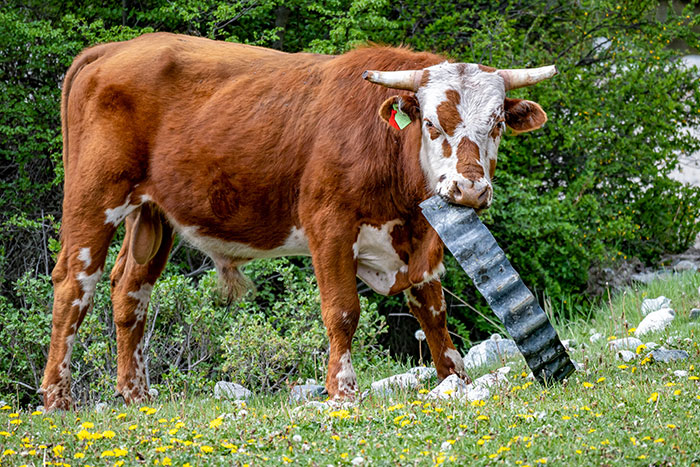
There are some aspects of summertime thunderstorms many people enjoy: feeling the air cool, watching the clouds roll in, seeing lightening shoot across the sky. What isn’t as exciting about these storms is the damage they may leave behind.
Although wind damage to buildings and crop fields might be obvious, debris that is blown into pastures and hayfields is sometimes less noticeable. These foreign objects can cause significant health risks to grazing livestock, as well as animals fed harvested forage.
Warren Rusche, assistant professor and feedlot specialist with South Dakota State University Extension, says grazing livestock often eat items other than plant material that appear in a field after a severe weather event. This can upset digestion and cause hardware disease, which is defined as physical injury to an animal’s digestive tract after consuming a metal object.
“Metal objects are well-recognized risks, but even ingested items such as fiberglass insultation can lead to blockage, bloat, or irritation to the digestive tract,” Rusche states. “Managers should observe cattle closely and be ready to contact their veterinarian for prompt intervention and treatment if necessary.”
In addition to its threat to pastures, storm debris in hayfields is an even greater concern. Rusche says smaller pieces of debris that would otherwise go untouched by grazing livestock could end up in baled or chopped forage. Moreover, the time in between severe weather and forage harvest may be much longer than the time between that and grazing.
“Time delays increase the chance that managers overlook the risk from ingestion of foreign material, simply because dealing with other production issues take precedence,” Rusche notes. “One also cannot overlook that storm debris increases the risk of tire or mechanical damage to harvesting equipment,” he adds.
Prevent and protect
Safeguard animals and equipment by picking up debris in pastures and hayfields after a storm.
This may be easier said than done, especially if there are multiple areas on a farm that received damage, but Rusche recommends removing heavy pieces of debris with machinery first and then going after smaller pieces of debris by hand. Use a drone, if possible, to get an aerial view of an area to lessen the time spent looking for foreign objects in a field.
Another preventative action that can be taken if debris is a potential problem is inserting a magnet in the rumen of animals. This will prevent metal objects from harming an animal’s digestive tract.
“If administering magnets to a large group of livestock is impractical, targeting higher-value individuals such as herd sires or particularly valuable seedstock animals may be an effective compromise to protect against hardware disease, either while grazing or consuming stored feed,” Rusche suggests.
Even after cleaning up, bits of debris may still be present in harvested forage. Assess forage for foreign objects, and keep this crop separate from other harvests. Rusche advises producers to feed forage from fields affected by debris to animals like finishing cattle in small amounts for a short amount of time. Do not feed it to animals that require greater amounts of forage with longer productive lifespans.

Amber Friedrichsen is the 2022 Hay & Forage Grower editorial intern. She currently attends Iowa State University where she is majoring in agriculture and life sciences education-communications and agronomy. Friedrichsen grew up on her family’s diversified crop and livestock farm near Clinton, Iowa.

